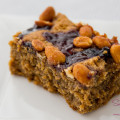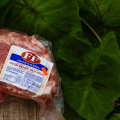 These Shiso Pork Skewers are one of the handful of recipes that I contributed to The ‘Ohana Grill Cookbook. Many yakitori places serve grilled pork with shiso, and they’re one of my family’s favorites. Of course, they serve them two pieces at a time and we can never get enough, so I came up with this recipe so we could stuff ourselves to our hearts’ content. The first place that Shake and I ever had the grilled-pork-shiso combo was at Tokkuri Tei, and there they prepared it like little pinwheels, so that’s how I do it. Other places take a simpler approach and sandwich the shiso between a couple pieces of pork belly. They’re not as pretty, and not as substantially meaty as the pinwheels. When we do these at home, we make a ton and have it as the main dish.
These Shiso Pork Skewers are one of the handful of recipes that I contributed to The ‘Ohana Grill Cookbook. Many yakitori places serve grilled pork with shiso, and they’re one of my family’s favorites. Of course, they serve them two pieces at a time and we can never get enough, so I came up with this recipe so we could stuff ourselves to our hearts’ content. The first place that Shake and I ever had the grilled-pork-shiso combo was at Tokkuri Tei, and there they prepared it like little pinwheels, so that’s how I do it. Other places take a simpler approach and sandwich the shiso between a couple pieces of pork belly. They’re not as pretty, and not as substantially meaty as the pinwheels. When we do these at home, we make a ton and have it as the main dish.
Look for thin-cut pork that has a nice amount of fat (not too lean—it ends up too dry), but not as fatty as belly cuts. We’ve found that Marukai sells a cut labeled “thin-cut pork steak” and it’s a great mix of meat and fat; they don’t always have it, though, so sometimes I just have to improvise with whatever they have on hand. Whatever you get, it needs to be boneless and about 1/8-inch thick.
 Local Hawai‘i markets usually have something that works, and on the mainland, if you have an Asian grocery store near you, you should be able to find a thin-cut pork option that works nicely for this. (If you can find a tonkatsu cut with a good amount of fat, those work well. Cuts meant for sukiyaki are too thin and not fatty enough.) Otherwise, a meat mallet is your best friend; find the thinnest cut of pork you can and pound out your stress. Or, if your butchery skills are better than mine, you could cut your own “sheets” of meat from a nicely marbled pork roast.
Local Hawai‘i markets usually have something that works, and on the mainland, if you have an Asian grocery store near you, you should be able to find a thin-cut pork option that works nicely for this. (If you can find a tonkatsu cut with a good amount of fat, those work well. Cuts meant for sukiyaki are too thin and not fatty enough.) Otherwise, a meat mallet is your best friend; find the thinnest cut of pork you can and pound out your stress. Or, if your butchery skills are better than mine, you could cut your own “sheets” of meat from a nicely marbled pork roast.
We really love shiso, but it does have a unique taste that some people find off-putting. It’s hard to describe; it belongs in the mint family (its English name is perilla or beefsteak leaf) and it has a somewhat similar herbaceous flavor, but it’s not pepperminty at all, not as bright as Italian basil or as licoricey as Thai basil, but refreshingly palate cleansing. The green variety is used more in its fresh form, and that’s what you may have seen in a sushi restaurant or at the grocery store, but if you’ve ever had yukari-seasoned anything (rice, chicken—our favorite sushi place, Torae Torae, does a fantastic grilled jidori chicken seasoned with yukari salt), those purple flakes are made of dried red shiso leaves. The green has more of a minty aspect to its flavor while the red, which is used to color pickled ume, is a bit more earthy.
 My parents have a few bicolor shiso bushes in their yard—the leaves are not as feathery (jagged, kind of maple-leaf-ish) on the edges as the green type, and they’re red on the bottom, green on the top side. (Some are red on both sides.) They get kind of out of control until my dad chops them back and pots a couple new starters and they get big and the whole cycle begins again. You can see here we have a new bush starting out. (I actually took this picture a couple weeks ago, and the bush has gotten way more scraggly and out of control since then, so when I got around to preparing to do this post, it was definitely time to harvest.)
My parents have a few bicolor shiso bushes in their yard—the leaves are not as feathery (jagged, kind of maple-leaf-ish) on the edges as the green type, and they’re red on the bottom, green on the top side. (Some are red on both sides.) They get kind of out of control until my dad chops them back and pots a couple new starters and they get big and the whole cycle begins again. You can see here we have a new bush starting out. (I actually took this picture a couple weeks ago, and the bush has gotten way more scraggly and out of control since then, so when I got around to preparing to do this post, it was definitely time to harvest.)
You can use red, green or bicolored shiso to make these pinwheels. I usually use the bicolored just because that’s what we’ve got readily available, and who’s gonna argue with FREE, right?! If you’re presented with a choice, though, I would go for the green. Our bushes were in the dying-off-due-to-neglect stage when Adrienne and I were doing the photos for the book, so I bought green leaves at the market. You can see the difference between those (in the photo at the beginning of this post) and the ones from the plant in our yard.
To assemble these shiso-pork skewers, first lay your pork out in a flat “sheet”—you may need to slightly overlap your pieces; it’s better that they overlap and you get a fat spot than for you to have a gap because that’s gonna suck when you roll the whole thing up. (You can also pound out any thick spots; that’ll help the meat fuse together, too.) Think of this as a meat jelly roll, where the pork is the dough and the shiso is the “jelly.”
I like to pretty much cover up all the pork with shiso, but that’s also because, again, I’m working with free product, so I don’t have to conserve anything. You can definitely space the leaves out a lot more and still get a good amount into each pinwheel. If you are really short on shiso, you could place it just along the bottom half (which will become the center, as you roll upward to create the jelly roll). That way you spread the love and ensure that each piece has at least a little shiso in the center.
Roll your pork and shiso up tightly—if it’s loose, it’ll be hard to skewer and be prone to falling apart, plus it’ll dry out more during cooking. If you’re having difficulty, you can start with a smaller meat rectangle. I am impatient, so I’d rather do a big log and cut up lots of pieces from it rather than making several smaller ones and getting fewer pieces.
Get the recipe for Shiso Pork Skewers below, or support Sugar + Shake by purchasing a copy of The ‘Ohana Grill Cookbook at Bookshop.org (using this link earns me an additional commission).
Shiso Pork Skewers
As featured in The ‘Ohana Grill Cookbook. (You can cheat, though, and do these in the broiler, if you aren’t able to use a grill.)
- 1½ to 2 pounds boneless, thin-cut pork (about 1/8-inch thick*)
- 12 to 20 shiso leaves
- Garlic salt and pepper, to taste
- Hawaiian salt
- Wood or metal skewers
Preheat a clean and oiled grill to high heat. Presoak your skewers, if using wooden ones.
Lay two or three pieces of pork next to each other, creating a large “pork rectangle” roughly the size of a sheet of printer paper. If the edges of your pieces aren’t completely straight, layer them slightly so that you have no gaps where they touch. Season lightly with garlic salt and pepper.
Lay shiso leaves out on top of the pork, spacing them fairly close together. (Shiso has an intense taste, so you may prefer to space them more widely, using fewer leaves; my family loves it, so we pack them in closely, with almost no gaps.)
Carefully roll the pork and shiso up like a jelly roll. Roll tightly to prevent it from falling apart during the skewering and grilling process. You should end up with a log about 2 inches in diameter and 10 to 12 inches long. Repeat the roll-making process until all the pork is used up.
Slice rolls into pieces about a half-inch thick. Skewer the rounds through their diameter; about 5 or 6 should fit per skewer. Season each side of the skewered pieces with Hawaiian salt.
Grill over high heat, about 4 to 6 minutes per side, until lightly charred. The pork cooks fast and if your pork is particularly fatty, they will flare up! Serve immediately.
Serves 4 to 6 as a main dish.
*A tonkatsu cut with a good amount of fat in the pork works well. Cuts meant for sukiyaki are too thin and not fatty enough. Otherwise, a meat mallet is your friend; find the thinnest cut of pork you can and pound out your stress.














Leave a Comment